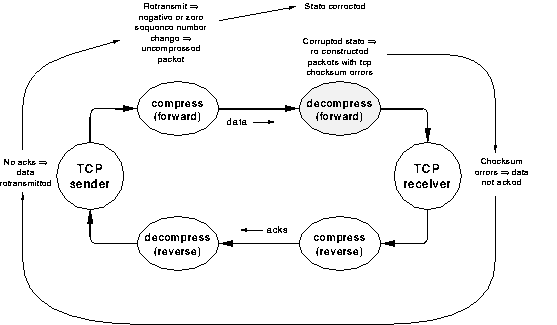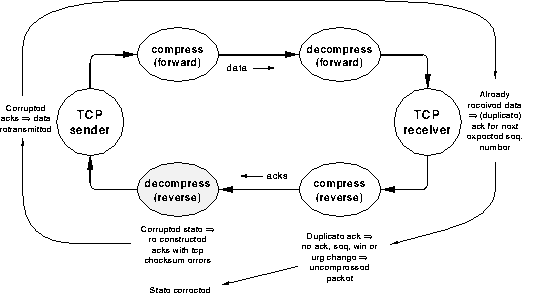
The previous section noted that after a CRC error the decompressor will introduce TCP checksum errors in every uncompressed packet. Although the checksum errors prevent data stream corruption, the TCP conversation won't be terribly useful until the decompressor again generates valid packets. How can this be forced to happen?
The decompressor generates invalid packets because its state (the saved `last packet header') disagrees with the compressor's state. An UNCOMPRESSED_TCP packet will correct the decompressor's state. Thus error recovery amounts to forcing an uncompressed packet out of the compressor whenever the decompressor is (or might be) confused.
The first thought is to take advantage of the full duplex communication link and have the decompressor send something to the compressor requesting an uncompressed packet. This is clearly undesirable since it constrains the topology more than the minimum suggested in sec. 2 and requires that a great deal of protocol be added to both the decompressor and compressor. A little thought convinces one that this alternative is not only undesirable, it simply won't work: Compressed packets are small and it's likely that a line hit will so completely obliterate one that the decompressor will get nothing at all. Thus packets are reconstructed incorrectly (because of the missing compressed packet) but only the TCP end points, not the decompressor, know that the packets are incorrect.
But the TCP end points know about the error and TCP is a reliable protocol designed to run over unreliable media. This means the end points must eventually take some sort of error recovery action and there's an obvious trigger for the compressor to resync the decompressor: send uncompressed packets whenever TCP is doing error recovery.

But how does the compressor recognize TCP error recovery? Consider the schematic TCP data transfer of fig. 6. The confused decompressor is in the forward (data transfer) half of the TCP conversation. The receiving TCP discards packets rather than acking them (because of the checksum errors), the sending TCP eventually times out and retransmits a packet, and the forward path compressor finds that the difference between the sequence number in the retransmitted packet and the sequence number in the last packet seen is either negative (if there were multiple packets in transit) or zero (one packet in transit). The first case is detected in the compression step that computes sequence number differences. The second case is detected in the step that checks the `special case' encodings but needs an additional test: It's fairly common for an interactive conversation to send a dataless ack packet followed by a data packet. The ack and data packet will have the same sequence numbers yet the data packet is not a retransmission. To prevent sending an unnecessary uncompressed packet, the length of the previous packet should be checked and, if it contained data, a zero sequence number change must indicate a retransmission.

A confused decompressor in the reverse (ack) half of the conversation is as easy to detect (fig. 7): The sending TCP discards acks (because they contain checksum errors), eventually times out, then retransmits some packet. The receiving TCP thus gets a duplicate packet and must generate an ack for the next expected sequence number[11, p. 69]. This ack will be a duplicate of the last ack the receiver generated so the reverse-path compressor will find no ack, seq number, window or urg change. If this happens for a packet that contains no data, the compressor assumes it is a duplicate ack sent in response to a retransmit and sends an UNCOMPRESSED_TCP packet./31/